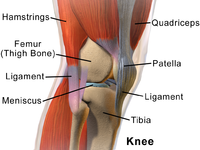
Photo from wikipedia
Purpose The purpose of this study was to compare the effectiveness of a flexion spacer in the clinical and radiological outcomes of patients who underwent total knee arthroplasty (TKA) and… Click to show full abstract
Purpose The purpose of this study was to compare the effectiveness of a flexion spacer in the clinical and radiological outcomes of patients who underwent total knee arthroplasty (TKA) and to compare these patients to a group of patients subjected to the same type of surgery but without the use of a flexion spacer. It was hypothesized that patients who underwent TKA using a flexion spacer would have better clinical and radiological outcomes than those without a flexion spacer in both short- and medium-term follow-ups. Methods A consecutive series of patients undergoing TKA were included, yielding 20 patients in the study group. The control group was identified from the consultant database of the senior author, yielding 21 patients who underwent the same operation. All 41 patients received a Vanguard Knee System (Zimmer-Biomet, Warsaw, Indiana, USA). Cases were defined as those patients who had undergone TKA using a flexion spacer device for gap balancing; controls were defined as patients who had undergone TKA without the support of a flexion spacer device. Patients were clinically and radiographically evaluated at two consecutive follow-ups: T 1 —13.1 ± 1.3 months and T 2 —108 ± 6 months. Clinical evaluation was performed using the Knee Society Scoring System and the Western Ontario, McMaster Universities Osteoarthritis Index score. Radiographic evaluation included the femoral angle ( α ), the tibial angle ( β ), the sagittal femoral ( γ ) angle and the tibial slope ( δ ). Furthermore, the lateral patellofemoral angle (LPFA) and the Caton-Deschamps index were evaluated. Results No statistically significant clinical differences were found between the two groups at T 1 and T 2 ; moreover, the clinical outcomes of the two groups were stable between the two follow-ups, with no significant improvement or worsening. Radiographic evaluation showed no difference in the two groups between T 1 and T 2 ; the only significant radiographic difference between the two groups concerned the LPFA (both at 30° and 60°) at each follow-up, which was significantly greater in cases than in controls ( p = 0.001). Conclusions The current study demonstrates that the use of a flexion spacer significantly improves radiographic patello-femoral tracking, although no significant clinical differences were found between the two groups. Level of evidence Case–control study, level III.
Journal Title: Knee Surgery, Sports Traumatology, Arthroscopy
Year Published: 2020
Link to full text (if available)
Share on Social Media: Sign Up to like & get
recommendations!